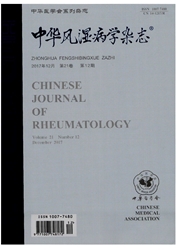

 中文摘要:
中文摘要:
目的 观察过氧化物酶体增殖物激活受体γ(PPARγ)在狼疮肾炎(LN)不同病变类型肾组织中的表达及其与肾脏病理改变之间的关系,探讨PPARγ在LN发病机制中的可能作用。方法 根据临床及肾活检病理诊断,选择LN不同病变类型患者作为研究对象,其中Ⅱ型(6例),Ⅳ型(8例),Ⅴ型(7例)。以肾脏肿瘤切除术中远离肿瘤部位的正常肾组织(6例)为对照。光镜下观察并计数肾脏病变活动指数、间质病变指数:用免疫组织化学方法对各例肾组织PPARγ的表达进行检测,并对其与肾脏病变的相关性进行分析。结果 LN患者肾组织肾小管、肾小球及间质浸润细胞中PPARγ表达较正常对照组均显著上调.其中Ⅳ型LN肾组织肾小管、肾小球及间质浸润细胞PPARγ表达显著高于Ⅱ型、Ⅴ型;肾小球PPARγ染色阳性细胞数目与肾脏病理活动积分及间质病变指数之间呈显著正相关(r=0.94;P〈0.01)。结论 PPARγ在LN肾组织肾小管、肾小球及间质浸润细胞高表达对于限制LN肾脏病变发展可能具有重要作用
 英文摘要:
英文摘要:
Objective To investigate the expression of peroxisome proliferator-activated receptor (PPARγ) in lupus nephritis (LN) patients and the possible mechanisms of PPARγ in the pathogenesis of LN. Method PPARγ expression was examined in 21 LN patients and 5 normal kidney biopsy specimens by immunohistochemical method. The relationship between PPARγ expression and renal pathologic changes was analyzed. Results Glomerular and tubular positive staining of PPARγ in LN patients was markedly up-regulated compared with that in normal kidney specimens. The distribution and expression of PPARγ in class IV was significantly increased compared with that in class V and H. The relevance assay showed that there was positive relationship between active index and glomerular PPARγ immunohistochemistry staining cell numbers (r=0.94, P〈0.01 ). Conclusion This study demonstrates in vivo that PPARγ expression is increased in active LN patients with pathological active inflammation. These data suggest that the increase of PPARγ expression in renal cells may play an important role in the pathogenesis of LN.
 同期刊论文项目
同期刊论文项目
 同项目期刊论文
同项目期刊论文
 Effect of 15d-PGJ2 on the expression of CD40 and RANTES induced by IFNγ and TNFα on renal tubular ep
Effect of 15d-PGJ2 on the expression of CD40 and RANTES induced by IFNγ and TNFα on renal tubular ep Constitutive expression of peroxisome proliferator –activated receptorγ(PPARγ) in rat peritoneal mes
Constitutive expression of peroxisome proliferator –activated receptorγ(PPARγ) in rat peritoneal mes PPARγ Ligands Downregulate the Expression of CD40 and ICAM-I Induced by LPS in Rat Peritoneal Mesoth
PPARγ Ligands Downregulate the Expression of CD40 and ICAM-I Induced by LPS in Rat Peritoneal Mesoth Effect of 15d-PGJ(2) on the expression of CD40 and RANTES induced by IFN-gamma and TNF-alpha on rena
Effect of 15d-PGJ(2) on the expression of CD40 and RANTES induced by IFN-gamma and TNF-alpha on rena Peroxisome proliferator-activated receptor-gamma is expressed by rat peritoneal mesothelial cells: I
Peroxisome proliferator-activated receptor-gamma is expressed by rat peritoneal mesothelial cells: I 期刊信息
期刊信息
